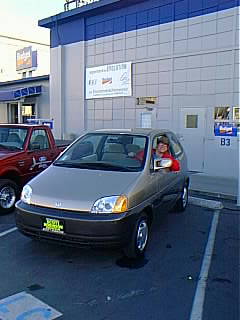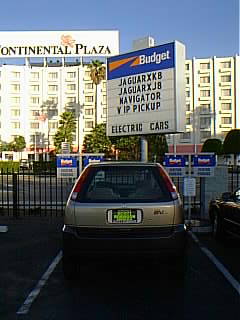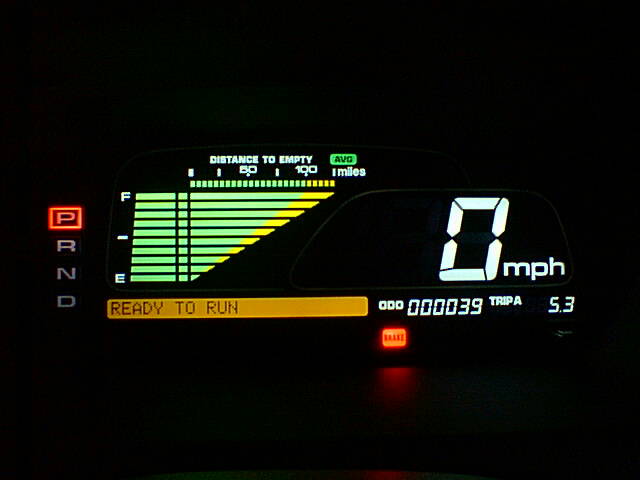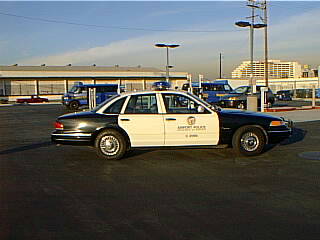

Home - AFV Events - Test Drives - Honda EV Plus
When I first reported on renting a General Motors EV1 electric car from EV Rental Cars in December 1998, I mentioned that one of my reasons for taking the car to work and giving lots of test rides was that I hope to persuade some of our corporate officers to ditch the Pontiacs the company leases for them in favor of electric vehicles. One officer, who's a "car guy" like me, sent me an e-mail saying that while he'd be interested in a test ride, the EV1 wouldn't be suitable for him because his company Pontiac is the only car he and his wife have with a reasonable amount of hauling capacity. The EV1, of course, carries two people and about two golf bags; it's a sports car, not a hauler.
However, the Honda EV Plus is an electric four-seat micro-minivan, about the size of a Mitsubishi Expo LRV, and with a hatchback and fold-down rear seats it's got more usable cargo volume than my old Chevy Caprice! I knew that EV Rental was going to get some EV Pluses, so I asked when they would be available to rent, and found that it was a couple of months sooner than I had thought. Thus I ended up being the first in line, and grabbed an EV Plus with 34 miles on its odometer on 14 January 1999.


The EV Plus was the first production electric car from a major automaker to use advanced batteries, namely nickel metal-hydride (NiMH) instead of lead-acid. Other electric vehicles that started out with lead-acid battery packs are now available with NiMH, either as an option (the 1999 EV1, and the Chevy S-10 and Ford Ranger pickups) or as standard equipment (the Dodge EPIC minivan). On comparing my EV Plus experience with my December day with a lead-acid 1997 EV1, I can sure see why everybody is switching! Take a look at the dash-panel display in the EV Plus:

The ten equal-length bars on the left indicate a full charge; the long, slant-cut bars to their right indicate how much range you can expect to get as you drain the battery pack to each of the ten "fuel-gauge" levels. The amber portion is the "ideal" range, i.e., what you would get if you drove very conservatively, and the green portion shows what you can expect given the way you have been driving--it's a "smart" range gauge like the numerical one on the EV1. You'll note that the "ideal" range is 125 miles, and that with the moderate but not pussyfoot driving I did in the first five miles or so I could still expect 100 miles! This is to be compared with 37 miles per charge that I got with the lead-acid EV1; of course, the weather was in the 40's and low 50's Fahrenheit in December compared to the 70's this month, which also affected the lead-acid battery pack more severely than it would a NiMH pack. Early reports from people with NiMH EV1's, even in the cold weather, are that it is good for 120 to 160 miles per charge around town! Given that GM is charging less than 20% extra for the NiMH option in the 1999 EV1 lease, I have to wonder if anybody is going to go for the (improved) lead-acid variant...
I probably gave fewer test-rides in the EV Plus than in the EV1 a month earlier, but to more people since I could take three passengers at a time instead of one. I also took the EV Plus on the freeway for about twenty miles, solo and with passengers, which cost me five to ten miles off the initial expectation of 100 miles per charge. The car isn't a hotrod like the EV1, but it certainly has enough acceleration to get the job done, and has no trouble at all with full freeway speeds or full passenger loads. Another difference I noticed between the two cars was in the regenerative braking system, which turns the motor into a generator to feed energy of motion back into the batteries as you slow down. The EV1 has a "coastdown" button that lets you decide whether regenerative braking cuts in when you lift your foot from the accelerator pedal, or only when you actually depress the brake pedal; if you choose the latter, then when you take your foot off the "gas" the EV1 simply coasts like a stickshift car with the clutch disengaged, but if you choose the "coastdown" mode then regenerative braking starts slowing you down immediately when you lift your foot. In the EV Plus, by contrast, "coastdown" is always enabled, but the system waits about a second after you release the accelerator before regenerative braking starts, so you don't suddenly jerk from accelerating to decelerating if you are the kind of impatient driver who hits the "gas" harder than necessary and then backs all the way off as you find your car rushing up on the car ahead. I don't know which system I'd prefer; I expect that one could adapt to whichever system one's car provided.
Actually, my understanding is that Honda is not going to lease the EV Plus for very much longer (even as the EV1 appears to be getting a second wind at GM, as I noted in my report on the 1999 model rollout). Honda already has the cleanest internal-combustion-engine vehicle ever tested by the EPA, the Civic GX powered by compressed natural gas (CNG), and later in 1999 they will be introducing the first mass-produced hybrid-electric vehicle to be made available in the US, beating the Toyota Prius by a year (though that has been available in Japan since late 1997). Though I don't have any particular "sources" or "inside information", some of the Honda folks with whom I've spoken have indicated that the company is going to concentrate on hybrid-electric vehicles for the mass market. Ironically, the "VV" prototype shown at the 1999 Detroit Auto Show is a two-seater like the EV1; this is after Honda "dissed" the EV1 for not having four seats and cargo space...
Many thanks to Terry O'Day and Joseph Borges, Jr. of EV Rental, to Lee Mehlman of Scott Robinson Honda in Torrance, CA, who alerted me that he was about to deliver two EV Pluses to them, to Laurie Little of Budget, who signed me out, and to Chuck Gustafson of Budget HQ in Chicago, who sped through the paperwork so I could rent the car before going out of town next week, and also before the $39.95 per day special rate expired. Apparently at this price (with reservation at 1-877-EVRENTAL, or $49.95 for walk-ups) they are oversubscribed, and have had to turn down business for lack of cars! They have already begun to get more cars, including the EV Plus I rented and another one, and their fleet will continue to grow. When the special rate expires in a week or two, they are going to let the price float with supply and demand; all I can say is that it's good to see there's that much demand for these vehicles!
And on a related topic, the Los Angeles International Airport is a center of alternative fuel use in the city; besides the new EV Rental operation, many shuttle vans and parking-lot buses run on natural gas. While I was headed back to work from the Budget lot I saw the first natural-gas-powered police car I have yet encountered, refueling at one of my van's usual stops. I just thought I'd include a photo here; you can see the EV Plus and two CNG SuperShuttle vans in the background. The airport police are one of a number of local forces that employ Ford Crown Victorias powered by CNG.

 Back
to AFV Events Page
Back
to AFV Events Page Back
to Fueling Station
Back
to Fueling Station Site
Map
Site
Map Contact
Me
Contact
Me All content copyright 1998-2024 by Mark Looper, except as noted. Reuse of my copyrighted material is authorized under Creative Commons Attribution 4.0 International license (CC BY 4.0).
![]()
![]()
new 16 January 1999